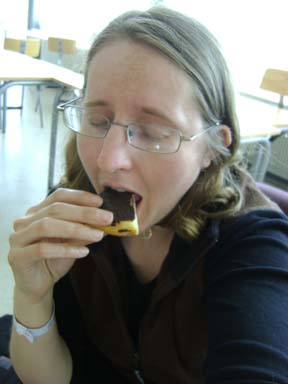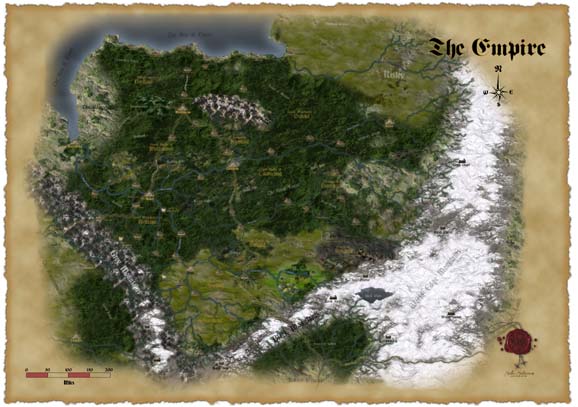2009-05-08: What is a Scenario--Slaaraphenland and The Hunt
by Emily
So many, many different ways to play games.
In Denmark, there is something called scenario play. A style of role-playing, it has many branches: semi-live, ensemble, their new wave influenced by Forge inspired indie games, and more. While in Denmark, I got to play some of these games and they were fantastic. Some are being translated into English as we speak. So I thought I'd start sketching out what goes into them. Here's a stab at some specifics.
Some characteristics of Danish scenario play:
- Prescripted events
- Descriptions of characters more important that stats
- Player choice more important than rolls
- Use of non-traditional framing (flashbacks)
- Emphasis on free play over resolution
I will leave it Frederik Jensen (who wrote about the Danish role playing tradition on Story Games) and others to say precisely where the games I'm describing here fall. But I'm starting with two that seem to exemplify some of the basic difference between their tabletop traditions and ours (USwise), before making a mad dash into even more wild and unknown territory as their semi-live or freeform. These two games are Slaaraphenland and The Hunt, which are both part of the the Empire Anthology, a broad-ranging, epic of a game.
The Empire Anthology
In Denmark, a group of writers got the idea to write a series of short games in the Warhammer Fantasy Empire universe. Called Imperiet: the Warhammer Empire Anthology, there are 10 games in the series, each taking somewhere around 90 minutes to play. They vary in tone from ironic and whimsical, to dark and psychological. Drawing inspiration from the world, each takes place in a specific town or region on the gorgeous map of the Empire (shown above). Each game involves a story of the peasants and warriors of that land.
That's where it really begins to diverge. They do use the Warhammer system, but in ways that would be very surprising to players here in the US. The games empower the GM and players to work together to create a story that is about very personal aspects of the characters: how they clash, their hopes, fears, joys and dark despairs. There is combat and conflict, but the games are instead about family loyalty and temptation. Rolls may be made occassionally, but they are pivot points, used to crank up the tension in inter-character scenes, not the culmination and majority of play.
Now, do forgive me, I am assuming I understand how folks here would play the game. But then, read what these takes on it are like, and you can decide.
The Hunt
The Hunt centers around a family that live in the Drakwald forest. Their village, empoverished and depleted of its men due to the war on Chaos, has been attacked. Three brothers hunt down a Beast that has robbed the village of a precious cow. We follow the brothers in their hunt, and interspersed are scenes from their past. We see their father, a fierce and loving warrior, stride off for battle in the war. We see his return; him now a broken man, and the brothers fighting for his approval and the love of a village maiden. The hunt continues, and the story of the brothers' choices and lives unfold.
The structure that makes this happen is the materials of the scenario, which are the bulk of the game. The characters and their conflicts are described. The scenes are written out. The exact form theproblems encountered by the brothers take is up to the GM, but strong suggestions are given, along with guidance on the issues to highlight in the character interactions. (The fear of the youngest brother, the lechery of the father, etc.)The action of the hunt is given meaning and context by the flashbacks. The whole lives of the characters are communicated.
A character sheet exists for each character, which is consulted when tests are needed in play. The rolls made are preceded by the playing out of the interactions among the brothers. Moments when dice are rolled are chosen judiciously: they demarcate moments of rising tension in the story. Providing risk and suspense, which has been heightened by the play in character.
Slaaraphenland

Slaaraphenland, is yet another tale of an impoverished village and the choices it's inhabitants make. Here you play four boys, friends, not brothers, who have heard the tales of Slaaraphenland, a Rock Candy Mountain-like fantasy land full of good things to eat and all you could desire. Stories say you can find it if you travel into the woods, so the boys head off into the dark beneath the trees.
Each has their own reason for going: one, the town preacher, to impress the ladies of the town, one, the greedy scholar, to get all he can for himself, another to not be left out and one to be able to carry through on the tall tales he's told. He lies to the rest, saying he has a map, which they follow blind. The boys travel, encountering other villagers and inhabitants of the forest. And meeting various temptations: to steal an apple from the old lady's tree? To break into a hunter's hut and eat their stewing dinner? To kill and eat a tiny, precious lamb? Sex with mysterious, bounteous ladies in the woods?

As they fall prey to temptation, they fall deeper and deeper into the spell of Slaaraphenland. Things become brighter around them, more dreamlike and fanciful. The player also feels the effect. With each choice to tread into temptation, the player must eat one slice of a rich, Danish cake. The cake is cut into 6 pieces. With the last piece eaten, the character can never return from Slaaraphenland, but stays there forever.
Each player has been given a character—made up of a short narrative description only—who has reason to seek out Slaaraphenland, and also to taste the fruits of temptation they find. But the choice is completely in the hands of the players. The GM reads or describes the scenario: the situation of the village, the legend of Slaaraphenland, the meetings in the woods, the land itself. But at each step, the game is about choosing which temptations to fall for (Markus Montola, for example, when playing held firm at breaking and entering a poor villager's hut, yet leapt delightedly into the hunt for the lamb).
The cake is unusual, as far as I know. Even in Denmark! Though there have been some indie games that have used food (Open Boat comes to mind). Here it leant a very interesting (dis)incentive to the players. We all left the table groaning from the leaden weight of the cake in our bellies. But it also added a feeling of verisimilitude for the players. We took the temptation ourselves, feeling the taste of the cake as we described our characters biting into the fluffy pancakes or nicely seasoned soup. Just think: we described what the food tasted like, and it mattered!
These are just a few of the sights and sounds of Danish role playing. More to come.
2009-05-10 23:44:20 Marc Majcher
I love this.
2009-05-18 16:50:02 John Kim
This sounds intriguing. I'm looking the material over now.
Were there any rules used in play other than the cake-eating?
2009-05-18 17:21:25 Emily
Just the unwritten things like: the gm reads/unfolds the scenario to you as you go along, and play your character to the hilt and embrace your reasons for deception and falling prey to temptation. :)
Actually, there was a bit more explicit stuff that tied to the cake: as you ate each piece, your character's experience of the world changed: colors, smells, tastes become more vivid. The draw of Slaaraphenland became stronger. After 5, I believe, you were not supposed to be able to escape once you get there. We fudged this a bit, but it was nicely done.
